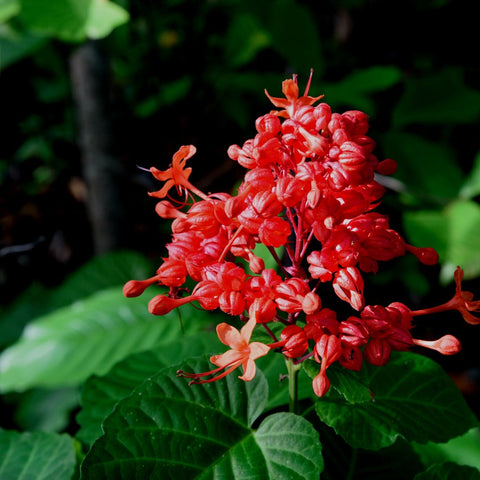Clerodendrum paniculatum (Pagoda flower)
The pagoda flower is a plant in the family Lamiaceae, native to China and Southeast Asia. It has been introduced into many other countries as an ornamental garden plant because of its showy inflorescences. The flowers are fragrant.
It is an evergreen plant. It grows best in well-drained soil and full sun. Clerodendrums prefer partial shade during the hottest part of the day. They require regular water and fertilizer during the growing season.
This species is a perennial herbaceous plant growing from a woody rootstock. Its stems grow up to about 8ft tall. The inflorescence consists of one or more large clusters of white-yellowish flowers which bloom between July and September.
The pagoda flower grows naturally throughout much of tropical and subtropical Asia. It can be found in India, Sri Lanka, Bangladesh, Myanmar, Thailand, Cambodia, Vietna.
The chemical composition of Clerodendrum paniculatum includes alkaloids, flavonoids, steroids, terpenoids, phenolics, saponins, glycosides, sterols, carbohydrates, amino acids, vitamins, minerals, fatty acids, and essential oils.

Medicinal uses of Clerodendrum paniculatum
- It is used for treating fever, headache, cough, sore throat, and rheumatism. The dried roots are boiled with water and then taken orally.
- It is used used to treat colds, flu, asthma, bronchitis, sinusitis, tonsillitis, pneumonia, tuberculosis, leprosy, eczema, psoriasis, skin diseases, ulcers, wounds, burns, snake bites, scorpion stings, insect bites, and toothache.
- Its root is used to cure jaundice, diabetes, dysentery, and malaria.
- The bark is used to treat diarrhea, dysentery, and stomachaches.
- The leaves are considered a stimulant and tonic.
- An infusion is made from the leaves, stems, roots, and flowers of the plant. It is consumed orally to treat diarrhea.
- A tincture is prepared from the leaves and flowers of the plant and applied externally to relieve abdominal pain.

How to grow Clerodendrum paniculatum
1. Choose the Right Container Size
Container size depends on the plant you're trying to grow. For example, a large pot is required for a tall shrub like Clerodendrum paniculatum.
2. Select the Best Potting Soil
Selecting the right soil is essential when growing plants inside. Here are some things to look for:
• Good drainage - Look for a soil that drains well so water doesn't sit around and cause root rot.
• Moisture content - Water needs vary depending on the type of plant you're growing. Check the label on the bag to ensure the soil contains the correct amount of moisture.
3. Add Plant Food
Plant food is added to the soil before planting to encourage growth. There are several options available including fertilizer pellets, granules, liquids, and tablets.
4. Prepare the Garden Site
Preparing the garden site involves clearing away weeds, debris, rocks, etc., to give the roots room to spread out.
5. Place the Seedlings
Seedlings are placed directly into the soil after being washed thoroughly. They may be covered with plastic wrap until they sprout.
6. Monitor Growth
Once seedlings have sprouted, it's important to monitor their progress. Keep an eye on them daily to ensure they receive adequate sunlight, water, and nutrients.
7. Transplant When Ready
When your plant has reached about 2 inches high, it's time to transplant it into larger pots or the ground.
8. Mulch Around Pots
Mulching helps keep the soil cool and moist while preventing weed seeds from germinating. You can use newspaper, shredded paper, wood chips, peat moss, composted manure, straw, or any other material that will decompose over time.
9. Water Well
Watering is one of the most important aspects of caring for plants. Be sure to provide enough water at regular intervals during dry spells.
10. Fertilize Regularly
Fertilizing encourages healthy plant growth and prevents nutrient deficiencies. A balanced fertilizer should be applied every two weeks.
11. Prune Dead Leaves
Dead leaves should be removed regularly to prevent disease and pests from taking hold.
12. Repot as Needed
Repotting ensures that your plant receives plenty of light and air circulation. This promotes healthy growth.
13. Maintain Healthy Conditions
Keep your plants free of insects by using insecticidal soap and spraying weekly. Also, remove dead leaves regularly.

Next step
Gardener services
Landscaping services
Online nursery
Organic pesticides and fertilizers
Extra reading
12 months flowering plants in India
Manoranjitha (Artabotrys odoratissimus)
Night queen (Cestrum nocturnum)
Nithya pushpa (Catharanthus roseus)
Happy Gardening!
Dr. Vandana K.

